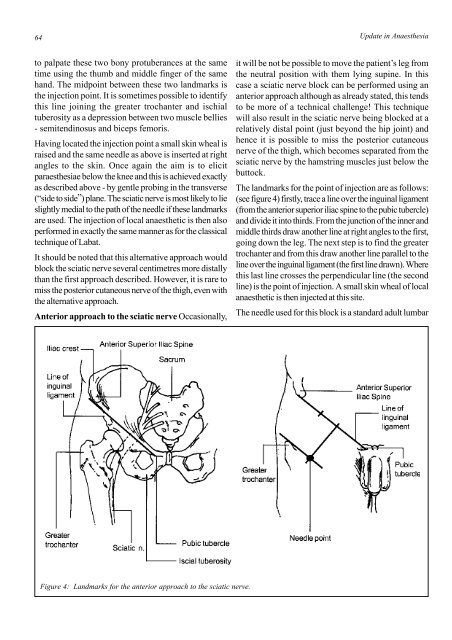Download Update 11 - Update in Anaesthesia - WFSA
Download Update 11 - Update in Anaesthesia - WFSA
Download Update 11 - Update in Anaesthesia - WFSA
Create successful ePaper yourself
Turn your PDF publications into a flip-book with our unique Google optimized e-Paper software.
64<strong>Update</strong> <strong>in</strong> <strong>Anaesthesia</strong>to palpate these two bony protuberances at the sametime us<strong>in</strong>g the thumb and middle f<strong>in</strong>ger of the samehand. The midpo<strong>in</strong>t between these two landmarks isthe <strong>in</strong>jection po<strong>in</strong>t. It is sometimes possible to identifythis l<strong>in</strong>e jo<strong>in</strong><strong>in</strong>g the greater trochanter and ischialtuberosity as a depression between two muscle bellies- semitend<strong>in</strong>osus and biceps femoris.Hav<strong>in</strong>g located the <strong>in</strong>jection po<strong>in</strong>t a small sk<strong>in</strong> wheal israised and the same needle as above is <strong>in</strong>serted at rightangles to the sk<strong>in</strong>. Once aga<strong>in</strong> the aim is to elicitparaesthesiae below the knee and this is achieved exactlyas described above - by gentle prob<strong>in</strong>g <strong>in</strong> the transverse(“side to side”) plane. The sciatic nerve is most likely to lieslightly medial to the path of the needle if these landmarksare used. The <strong>in</strong>jection of local anaesthetic is then alsoperformed <strong>in</strong> exactly the same manner as for the classicaltechnique of Labat.It should be noted that this alternative approach wouldblock the sciatic nerve several centimetres more distallythan the first approach described. However, it is rare tomiss the posterior cutaneous nerve of the thigh, even withthe alternative approach.Anterior approach to the sciatic nerve Occasionally,it will be not be possible to move the patient’s leg fromthe neutral position with them ly<strong>in</strong>g sup<strong>in</strong>e. In thiscase a sciatic nerve block can be performed us<strong>in</strong>g ananterior approach although as already stated, this tendsto be more of a technical challenge! This techniquewill also result <strong>in</strong> the sciatic nerve be<strong>in</strong>g blocked at arelatively distal po<strong>in</strong>t (just beyond the hip jo<strong>in</strong>t) andhence it is possible to miss the posterior cutaneousnerve of the thigh, which becomes separated from thesciatic nerve by the hamstr<strong>in</strong>g muscles just below thebuttock.The landmarks for the po<strong>in</strong>t of <strong>in</strong>jection are as follows:(see figure 4) firstly, trace a l<strong>in</strong>e over the <strong>in</strong>gu<strong>in</strong>al ligament(from the anterior superior iliac sp<strong>in</strong>e to the pubic tubercle)and divide it <strong>in</strong>to thirds. From the junction of the <strong>in</strong>ner andmiddle thirds draw another l<strong>in</strong>e at right angles to the first,go<strong>in</strong>g down the leg. The next step is to f<strong>in</strong>d the greatertrochanter and from this draw another l<strong>in</strong>e parallel to thel<strong>in</strong>e over the <strong>in</strong>gu<strong>in</strong>al ligament (the first l<strong>in</strong>e drawn). Wherethis last l<strong>in</strong>e crosses the perpendicular l<strong>in</strong>e (the secondl<strong>in</strong>e) is the po<strong>in</strong>t of <strong>in</strong>jection. A small sk<strong>in</strong> wheal of localanaesthetic is then <strong>in</strong>jected at this site.The needle used for this block is a standard adult lumbarFigure 4: Landmarks for the anterior approach to the sciatic nerve.
















